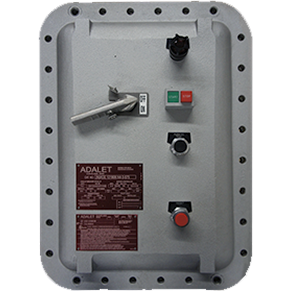Flameproof and explosion proof enclosures have subtle differences and maybe following the different standards, which are used for ensuring equipment and enclosures safety in Europe and North America.

The terms flameproof and explosion proof have one and the same meaning, in that the enclosures are constructed to have features through which the internal ignition within an enclosure is not transferred or transmitted to the outside. Therefore these enclosures safeguard the operational exteriors, which may have the flammable substances that can be a cause of fire and/or explosion.
ANSI/UL 1203 (Explosion proof panels)
The ANSI/UL 1203 standard is used in North America and details the requirements relating to the dust/ignition proof and explosion proof enclosure and electrical equipment that are installed in a hazardous environment. It also includes the requirements for equipment to be used in Class 1 & 2, Group A, B, C and D, and the Division 1 scenarios.
IEC 60079-1 (Flame-proof)
The IEC 60079-1 standard is specific to Europe and is also supported by the IEC 60079-0 standard of general requirements relating to the electrical apparatus. The standard provides the specific regulations for electrical equipment that are to be used in the explosive and hazardous gas environment.
The Underlying Differences
Below are the underlying differences between the European and North American standards.
General Differences
IEC 60079-1 is specific to gas and vapour, while ANSI/UL 60079-1 covers dust and gas. Different vapours and gasses are also grouped differently under the various divisions and classes in the standard ANSI/UL 60079. On the other hand, the ICC 60079-1 groups the gases together in its Group to 2C.
Constructional Differences
The North American ANSI/UL1203 standard specifically points out towards the weather-proofing and ingress requirements for the electrical enclosure that is to be placed outdoors. This IP rating is not present in the IEC 60079-1 standard. The IEC standards also do not have the wall thickness or gasket requirements for the enclosure while the same is present in the ANSI/UL standard. The ANSI/UL standards are also more explicit regarding the conduit cabling systems, plugs, valves, fittings and rust protection. The North American standard has a more stringent requirement for the non-metallic enclosures while requiring certain extra performance tests as well.
Also Read: Get High Quality Explosion Proof Motor Control Panels in Canada
Which Standard Should Be Your Choice
IEC 60079-1 is a widely accepted and internationally recognised standard for all kinds of flameproof enclosures. But one cannot ignore the size and depth of North American market and therefore following of the ANSI/UL 1203 standard also becomes necessary. North America has also drifted towards the adopted version of the standard IEC 60079-1, the ANSI/ISA 60079-1 Standard, which also has many deviations as well. As the differences narrow down, the future is bright and welcoming for the manufacturers.
The leading manufacturers can help you find the right hazardous location panel and enclosure that complies with the standards of the respective markets. They carry out the extensive confirmatory and assessment works to ensure that the panels befit the given hazardous environment and can protect your processes from any kind of danger and mishap. The best of suppliers are also operating online and provide to you the world-class electrical enclosures and panels with all the features you desire, at an affordable and marginal cost.
